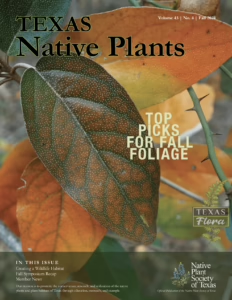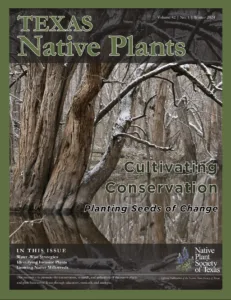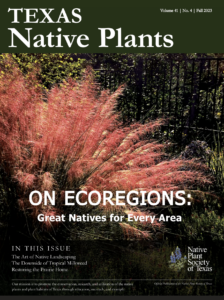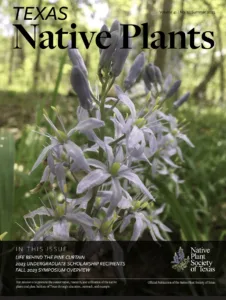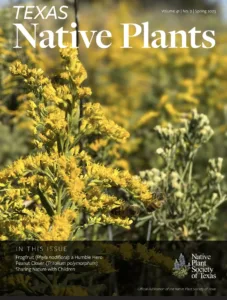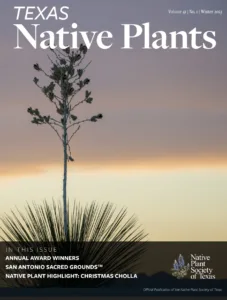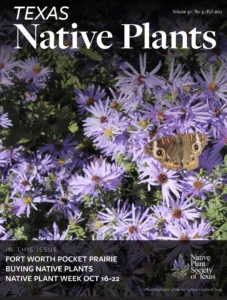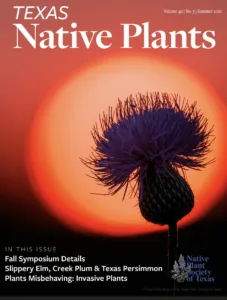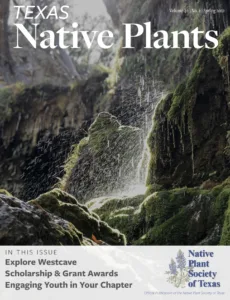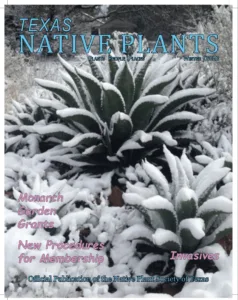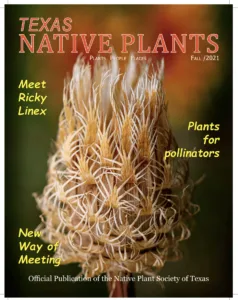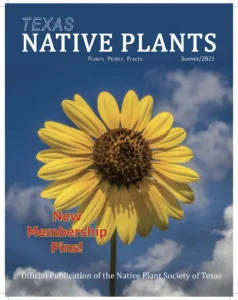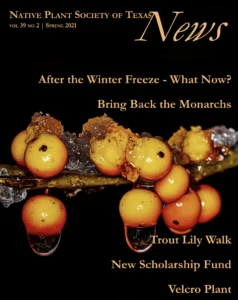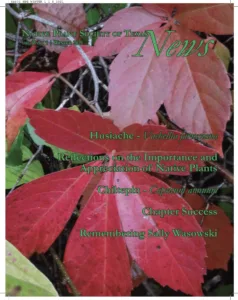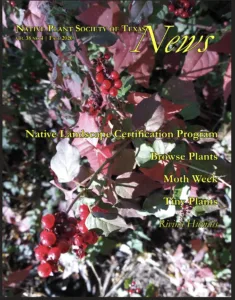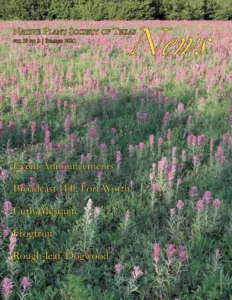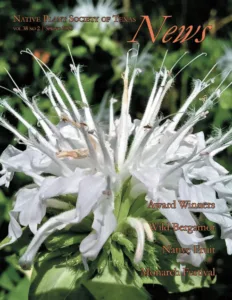Latest Issues

Winter 2025 Member Magazine
Executive Summary | 2024 Society Awards | Nature’s Winter Pantry | Native Plants at TWU | Lawn-free Living |Masters of Disguise | Member News
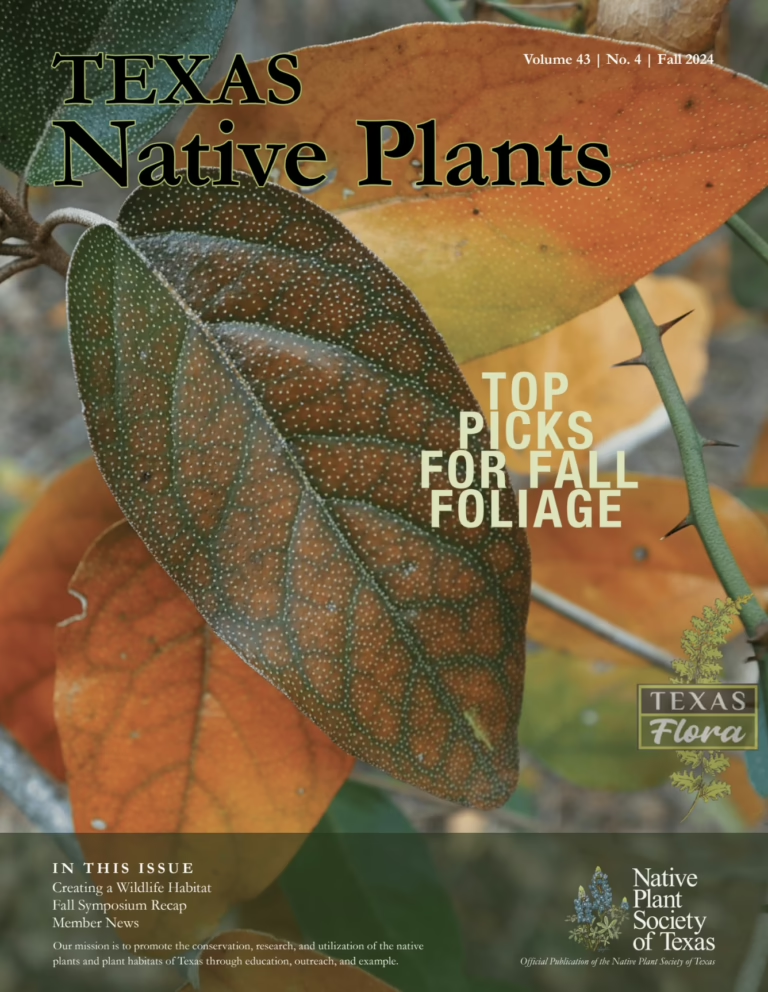
Fall 2024 Member Magazine
Executive Director’s Message | President’s Message | Fall Symposium Recap | Top Picks for Fall Foliage | Creating a Wildlife Habitat | Exceptional Native Plants | Plateau Meets Prairie | Member News
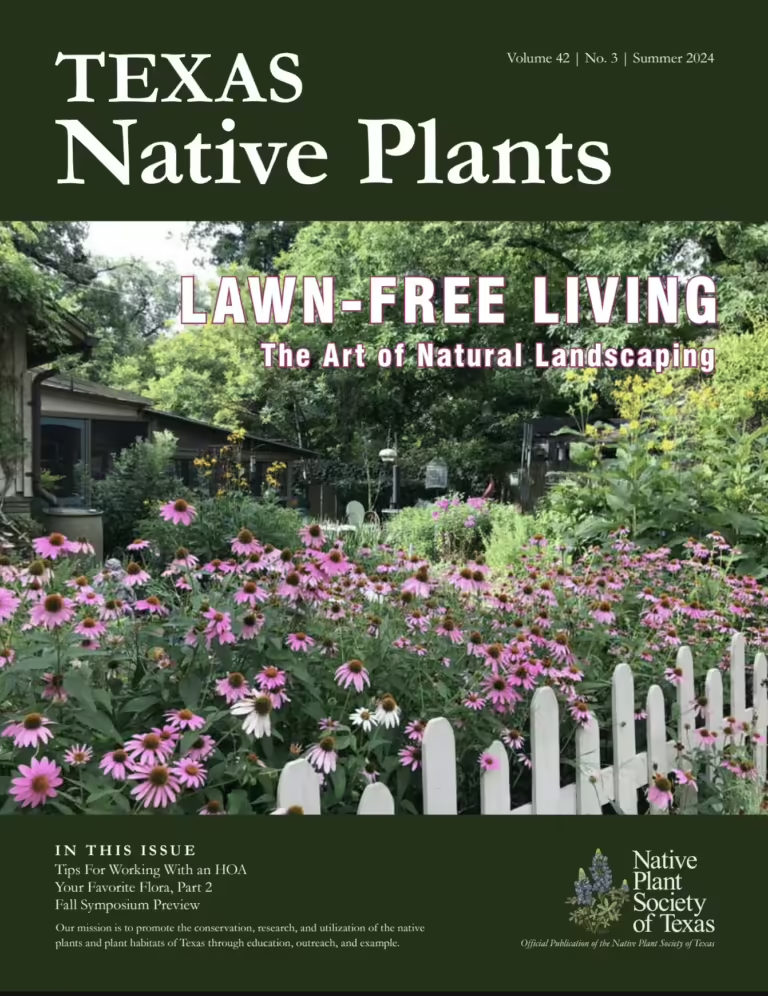
Summer 2024 Member Magazine
Tips for Working with Your HOA | Lawn-Free Living – The Art of Natural Landscaping | Creating Sanctuary In A Serene Woodland Retreat | From Urban Lawn To Natural Habitat | From Ashes And Flames, A Wildlife Haven Comes Alive | Your Favorite Flora Revealed | Musings On Starting Two Society Chapters | Rio Grande Valley Chapter to Manage Native Plant Center | Transforming Urban Spaces With Native Garden | The Hidden Perks of Native Plants in Cities | Transform Eyesores Into Micro Meadows With Native Plants
Distribution
- Texas Native Plants is published quarterly and the digital version is distributed free to all Society members in current standing.
- The digital version is also available in our library below.
- Print versions are mailed at no cost to Society members in current standing who select to receive a print copy when they join/renew.
- Libraries, educational institutions and other organizations may qualify to receive the publication for a $5 annual fee.
- Contact the membership coordinator.
- Many of our chapters publish their own newsletters and websites.
- These have their own deadlines and guidelines. See list of chapters.
History
Since its founding the Society has provided a news periodical to its members. there have been a variety of names and formats. The Texas Wildfower Newsletter edited by Carroll Abbott served as the first newsletter. He advocated the formation of the Native Plant Society of Texas in his quarterly publication Texas Wildflower Newsletter. After the Society was created in 1980, a free subscription to Abbott’s newsletter was provided as a benefit to all members. His declining health eventually prompted Abbott to request that the Society start its own newsletter. Lean more about the Carroll Abbott story.
Beginning in 1983 our own official publication has documented the evolution of the native plant movement and the Native Plant Society of Texas. The publication has had several slightly different names and formats over the years. By 2005 it had evolved into a full-color glossy magazine.
Editorial Submissions
The Native Plant Society of Texas encourages submission of articles, photos, pertinent news or other interesting information for publication.
- Submit articles or written items as email attachments.
- Send photos as email attachments in JPG, RAW or TIFF format.
- Larger file size and best quality are preferable.
- Contact the Editor for more information.
We reserve the right to edit all submissions for accuracy, relevance, length, grammar or for other reason. In matters of style our print publication generally follows the Chicago Manual of Style.
Unless prior arrangements with the editor are made, submissions may also appear on our website and linked on our social media pages. We do not accept outside advertising in any of our publications.
Publications Library
Click below to view issues by year/editor. Or visit our online archive.
2025 – Winter
- Executive Summary
- 2024 Society Awards
- Nature’s Winter Pantry
- Native Plants at TWU
- Lawn-free Living
- Masters of Disguise
- Member News
2024 – Fall
- Executive Director’s Message
- President’s Message
- Fall Symposium Recap
- Top Picks for Fall Foliage
- Creating a Wildlife Habitat
- Exceptional Native Plants
- Plateau Meets Prairie
- Member News
2024 – Summer
- Tips for Working with Your HOA
- Lawn-Free Living – The Art of Natural Landscaping
- Creating Sanctuary In A Serene Woodland Retreat
- From Urban Lawn To Natural Habitat
- From Ashes And Flames, A Wildlife Haven Comes Alive
- Your Favorite Flora Revealed
- Musings On Starting Two Society Chapters
- Rio Grande Valley Chapter to Manage Native Plant Center
- Transforming Urban Spaces With Native Garden
- The Hidden Perks of Native Plants in Cities
- Transform Eyesores Into Micro Meadows With Native Plants
2024 – Spring
- A Spring to Remember
- Welcoming Spring with Open Arms
- 2023 Ann Miller Gonzalez Research Grant Recipients
- Wet and Wild: Diving into the Underworld of Aquatic Plants
- Hidden Gems: Unique Landscaping Options
- Your Favorite Flora Revealed
- Inviting the Prairie Into Your Home Landscape
- Remembering “Mr. Bluebonnet”
- Spreading the Monarch Mission
- Gardening with a Purpose
- Save Time Landscape Planning This Spring
2024 – Winter
- Water -Wise Strategies
- Identifying Invasive Plants
- Growing Native Milkweeds
2023 – Fall
- Texas Ecoregions Thrive with Native Plants
- The Art of Native Plant Landscaping: From Mistakes to Mastery
- Choose Native over Tropical Milkweed
- Restoring My Prairie Home
- Choosing Nature’s Best
- Honoring a Historic Site with Native Plants
- Member Success Story: Be the Change
- Garden Signs Are Well Received
- Native Plants Shine at HOA Event
- Container Gardening with Native Plants
- My Journey with Native Plants
2023 – Summer
- Arboretum San Antonio
- Life Behind the Pine Curtain
- Featured San Antonio Member
- 2023 Scholarship Recipients
- Eradicate Bastard Cabbage
- Annual Contests
- Landscaping’s Many Myths
- Open Exec. Officer Positions
- Tyler Chapter Restarting
- Fall Symposium Overview
- Links You May Have Missed
2023 – Spring
- In Praise of Demonstration Gardens
- Frogfruit (Phyla nodiflora): A Humble Hero
- Sharing Nature with Children
- The Lawn Dilemma
- Never Forget Garden
- Peanut clover (Trifolium polymorphum)
2023 – Winter
- Annual Award Winners
- San Antonio Sacred Grounds
- Christmas Cholla
2022 – Fall
- Fort Worth Pocket Prairie
- Buying Native Plants
- Texas Native Plant Week
2022 – Summer
- Fall Symposium Details
- Slippery Elm, Creek Plum & Texas Persimmon
- Plants Misbehaving: Invasive Plants
2022 – Spring
- Explore Westcave
- Scholarship & Grant Awards
- Engaging Youth in Your Chapter
2022 – Winter
- Invasives
- New Membership Portal
- New NLCP Coordinator Linda Foss
2021 – Fall
- Meet Ricky!
- Plants for pollinators
- Virtual meetings
2021 – Summer
- Member Pins
- Identifying Milkweed Species
- Native Mulberries
2021 – Spring
- Trout Lily Walk
- Velcro Plant
- After the Winter Freeze – What Now?
2021 – Winter
- Huisache
- Remembering Sally Wasowski
- Chiltepin – Capsicum annuum
2020 – Summer
- Broadcast Hill
- Curly Mesquite
- Frogfruit
- Roughleaf Dogwood
2020 – Spring
- Native Fruit
- Wild Bergamot
- Monarch Festival



